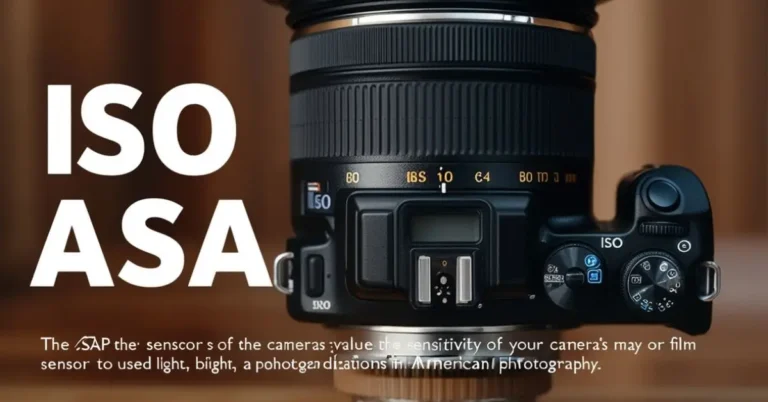ISO/ASA settings play a crucial role in photography, influencing how light or dark an image appears. Mastering ISO adjustments allows photographers to work in various lighting conditions and achieve their desired creative effects. Whether you’re new to photography or looking to refine your skills, understanding how to adjust the ISO/ASA is fundamental.
What is ISO/ASA in Photography?
ISO (International Organization for Standardization) and ASA (American Standards Association) refer to the sensitivity of your camera’s sensor (in digital photography) or film (in analog photography) to light. While the terms are often used interchangeably, ASA is typically associated with film photography, whereas ISO is more relevant to digital cameras.
A lower ISO value (e.g., ISO 100) indicates lower sensitivity to light, making it ideal for bright environments. On the other hand, a higher ISO value (e.g., ISO 800 or 1600) increases sensitivity, allowing for better results in low-light conditions.
Why ISO/ASA Matters
ISO/ASA settings affect the overall exposure of your images. Alongside aperture and shutter speed, ISO forms part of the exposure triangle, a fundamental concept in photography. Adjusting ISO can help balance exposure when changing lighting conditions or creative choices require adjustments to aperture or shutter speed.
However, increasing ISO introduces noise or grain into your images, which can reduce overall image quality. Finding the right balance between ISO and other exposure settings is essential to capturing sharp, well-exposed photographs.
How to Adjust ISO on Digital Cameras
Modern digital cameras make adjusting ISO straightforward. Here’s how to do it:
- Locate the ISO Button or Menu • Most cameras have a dedicated ISO button, typically labeled “ISO” or featuring a sun/brightness icon. If your camera lacks a dedicated button, access ISO settings through the camera’s main menu or quick menu.
- Select the Desired ISO Value • After pressing the ISO button or entering the menu, use the control dial or navigation buttons to select the desired ISO setting. • Lower values like ISO 100-200 are ideal for bright, outdoor conditions, while higher values (ISO 800-3200) suit low-light scenarios.
- Confirm and Capture • Confirm your selection by pressing the shutter button halfway or navigating to the exit menu. You’re now ready to shoot with the new ISO setting.
How to Adjust ASA on Film Cameras
In film photography, ASA values correspond to the film’s light sensitivity. The process of setting ASA is slightly different from digital adjustments:
- Check the Film’s ASA Rating • Film rolls are labeled with their ASA value (e.g., ASA 200 or ASA 400). Ensure you choose film appropriate for your shooting environment.
- Adjust the ASA Dial • Locate the ASA dial on your camera, often near the shutter speed dial. Lift and rotate it until the correct ASA value aligns with the indicator.
- Shoot According to ASA • Since ASA cannot be changed mid-roll, choose the right film speed for your project before loading the camera. Adjust other exposure settings (aperture and shutter speed) as needed.
Understanding ISO/ASA Values
ISO/ASA values typically follow a standard progression: 100, 200, 400, 800, 1600, and higher. Each step doubles the sensor’s light sensitivity. Here’s a breakdown of when to use specific values:
| ISO/ASA Value | Light Sensitivity | Best For |
|---|---|---|
| 100-200 | Low sensitivity | Bright daylight, outdoor photography |
| 400 | Moderate | Overcast days, indoor lighting |
| 800-1600 | High | Low-light environments, evening shots |
| 3200 and above | Very high | Night photography, concerts |
Tips for Adjusting ISO/ASA
- Use the Lowest ISO Possible • Keeping ISO low preserves image quality and reduces noise. Only increase ISO when necessary.
- Compensate with Aperture and Shutter Speed • If increasing ISO introduces too much noise, try adjusting the aperture (widen it for more light) or lowering the shutter speed (keeping it open longer).
- Test Different ISO Settings • Experiment in different lighting conditions to see how ISO affects image quality. This will help you understand the trade-offs.
- Use Noise Reduction Software • Post-processing tools can reduce noise, but the best approach is to manage ISO properly during shooting.
Practical Examples
- Bright Outdoor Scene • Use ISO 100 or 200. This keeps the image crisp and clear, minimizing the chance of overexposure.
- Indoor Event with Dim Lighting • Increase ISO to 800 or 1600. Combine this with a wider aperture (e.g., f/2.8) and slower shutter speed to balance exposure.
- Night Photography • Use ISO 1600 or higher. Accept some noise but prioritize capturing enough light to expose the subject correctly.
Common ISO/ASA Mistakes to Avoid
- Using High ISO Unnecessarily • Avoid setting ISO too high if adequate lighting is available. High ISO can introduce unwanted noise, reducing image sharpness.
- Forgetting to Reset ISO • Always reset ISO to a lower value after shooting in low light to prevent overexposed images in subsequent shots.
- Neglecting the Exposure Triangle • Relying solely on ISO adjustments without considering aperture and shutter speed can lead to suboptimal results. Balance all three settings.
Comparing ISO vs ASA: Digital vs Film
While ISO and ASA serve the same purpose, their application differs:
| Aspect | ISO (Digital) | ASA (Film) |
| Flexibility | Adjustable for each shot | Fixed per film roll |
| Image Quality Impact | Digital noise at high ISO | Grain at high ASA |
| Workflow | Changeable via menu/button | Set manually on camera |
Final Thoughts
Understanding how to adjust ISO/ASA is essential for mastering exposure and enhancing your photography skills. By learning to balance light sensitivity with other settings, you can capture stunning images in any environment. Keep practicing, experiment with different lighting conditions, and embrace the creative control ISO adjustments provide.

